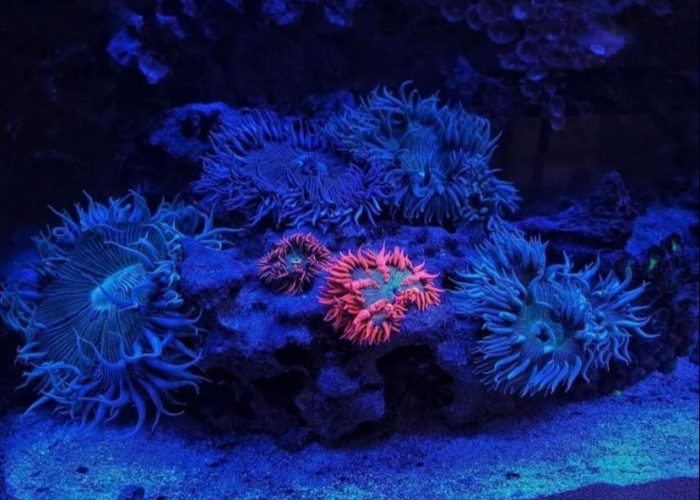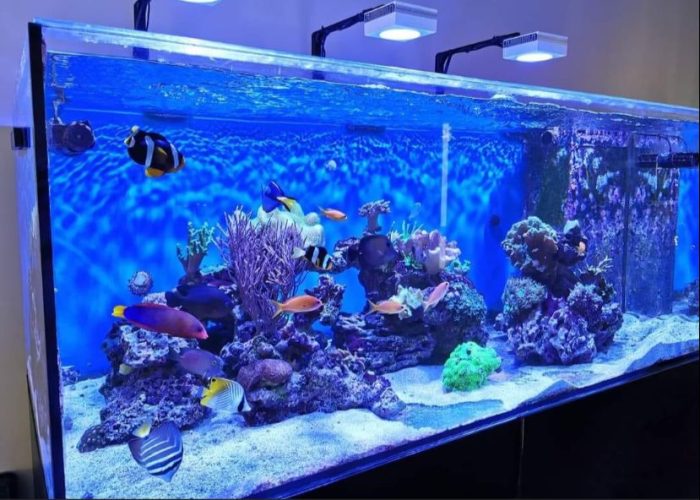Introduction:
Saltwater aquariums are captivating and vibrant ecosystems that allow us to bring the beauty of the ocean into our homes. The mesmerizing colors, fascinating marine life, and tranquil ambiance of a saltwater aquarium make it a popular choice among aquarium enthusiasts.
However, diving into the world of saltwater aquariums can be intimidating for beginners. With proper knowledge and guidance, anyone can embark on this rewarding journey. In this blog post, we will provide an introduction to saltwater aquariums, covering the basics of setting up and maintaining a thriving marine environment. Whether you’re a novice or have experience with freshwater aquariums, this guide will help you understand the key aspects of saltwater aquarium keeping and get you started on the right path.
1. Understanding Saltwater Aquariums

a) Marine vs. Freshwater: Saltwater aquariums are home to a diverse range of marine species that require specific water conditions and care. It’s important to note the fundamental differences between freshwater and saltwater aquariums, such as salinity, pH levels, and the need for specialized equipment.
b) Benefits and Challenges: Saltwater aquariums offer the opportunity to showcase vibrant coral reefs, exotic fish species, and unique invertebrates. However, they also present certain challenges, including higher costs, complex maintenance routines, and the need for careful monitoring of water parameters.
c) Types of Saltwater Aquariums: There are two primary types of saltwater aquariums: fish-only aquariums (FO) and reef aquariums. Fish-only setups showcase various fish species, while reef aquariums incorporate live corals, invertebrates, and a more intricate ecosystem.
2. Planning and Setting Up Your Saltwater Aquarium

a) Aquarium Size: Determine the size of the aquarium based on the available space, budget, and desired marine life. Larger aquariums offer more stability and a wider range of species, while smaller tanks require diligent monitoring and maintenance.
b) Equipment and Supplies: Invest in essential equipment, including an aquarium tank, filtration system, heater, protein skimmer, lighting, and a test kit for water parameters. Research and select reputable brands that meet the needs of your chosen setup.
c) Live Rock and Substrate: Live rock serves as the biological filtration and provides a natural aesthetic to the aquarium. Choose a quality live rock that is cured and free of unwanted pests. Select an appropriate substrate, such as sand or crushed coral, based on the species you plan to keep.
d) Cycling the Aquarium: Establishing a stable nitrogen cycle is crucial for the health of your saltwater aquarium. Cycling involves introducing beneficial bacteria into the aquarium to convert harmful ammonia into less toxic compounds. Use a source of ammonia, such as pure ammonium chloride or raw shrimp, to kickstart the cycle.
e) Water Parameters: Maintain the correct water parameters for the species you plan to keep. Monitor and adjust salinity, temperature, pH levels, ammonia, nitrite, and nitrate levels using a reliable test kit. Regular water changes are essential for maintaining water quality.
3. Choosing Saltwater Aquarium Inhabitants

a) Fish Selection: Research and select fish species that are suitable for your tank size and compatibility. Consider factors such as temperament, adult size, and the specific requirements of each species. Avoid overcrowding and provide good hiding places and swimming spaces.
b) Coral Selection: If you plan to create a reef aquarium, research the lighting and flow requirements of corals and select species accordingly. Start with hardy and beginner-friendly corals before progressing to more delicate and demanding varieties.
c) Invertebrates and Other Species: Explore the world of saltwater invertebrates, including shrimp, crabs, snails, and starfish, to add diversity and interest to your aquarium. Ensure compatibility and provide appropriate habitats and nutrition for each species.
d) Quarantine Procedures: Before introducing any new inhabitants into your saltwater aquarium, establish a quarantine process to prevent the spread of diseases or parasites. Quarantine fresh fish and invertebrates in a separate tank for observation and treatment if necessary
4. Maintenance and Care

a) Feeding: Provide a balanced diet for your saltwater aquarium inhabitants. Research the dietary needs of each species and offer a variety of foods, including high-quality flakes, pellets, frozen foods, and live or frozen brine shrimp.
b) Water Quality and Filtration: Regularly test and maintain optimal water parameters to ensure the health of your marine life. Conduct regular water changes to control nutrient levels and remove accumulated waste. Clean or replace filter media as required.
c) Lighting and Photoperiod: Adjust the lighting system based on the needs of your inhabitants. Most corals require specific light spectrums and intensity for photosynthesis and growth. Establish a photoperiod that mimics natural day-night cycles.
d) Regular Observations: Dedicate time to observing your saltwater aquarium daily. Monitor fish behavior, feeding patterns, and the overall health of the inhabitants. Look for signs of stress, disease, or aggression and address any issues promptly.
e) Maintenance Schedule: Establish a routine maintenance schedule for tasks such as water changes, cleaning the glass and equipment, and checking and adjusting water parameters. Consistency is vital in maintaining a stable and healthy saltwater aquarium.
Venturing into the world of saltwater aquariums is an exciting and rewarding journey. By understanding the key aspects of saltwater aquarium keeping, including planning and setting up the tank, choosing appropriate inhabitants, and maintaining water quality and care, you can create a thriving marine ecosystem in your own home.
Remember, patience, research, and regular maintenance are crucial for the long-term success of your saltwater aquarium. With dedication and a passion for marine life, you can enjoy the beauty and serenity of your saltwater aquarium while providing a safe and captivating habitat for your underwater companions.
